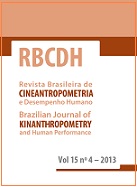Is the environment near school associated with active commuting to school among preschoolers?
DOI:
https://doi.org/10.1590/1980-0037.2013v15n4p393Abstract
Available studies show that environmental factors may influence how parentes choose to commute their children from home to school. Thus, the aim of this study was to analyze the association between the characteristics of the physical and social environment near school and active commuting to school among preschool children. A school-based cross-sectional study with a sample of children aged 3to 5 years (n=914) was undertaken. Participants were selected by a single-stage cluster sampling process. To obtain data on commuting to school and demographicand socioeconomic variables, a previously validated questionnaire was used while an audit tool was used to assess the environment near school. Binarylogistic regression was used to analyze the association and results were presented as Odds Ratio values. Results showed that 28.3% (95%CI 25.5-31.3) ofthe children were active commuters from home to school. A positive association was found between public transportation (p=0.002) and social environment(p=0.004) domains and active commuting. However, this association was foundonly among children from families that did not have a car. The likelihood of achild being an active commuter was higher among those who are enrolled in schools with better environmental surroundings (OR=1.88; 95%CI 1.31-2.70). It was concluded that there was a positive association between some of the environmental factors near school and active commuting to school among children from families that did not have a car.



